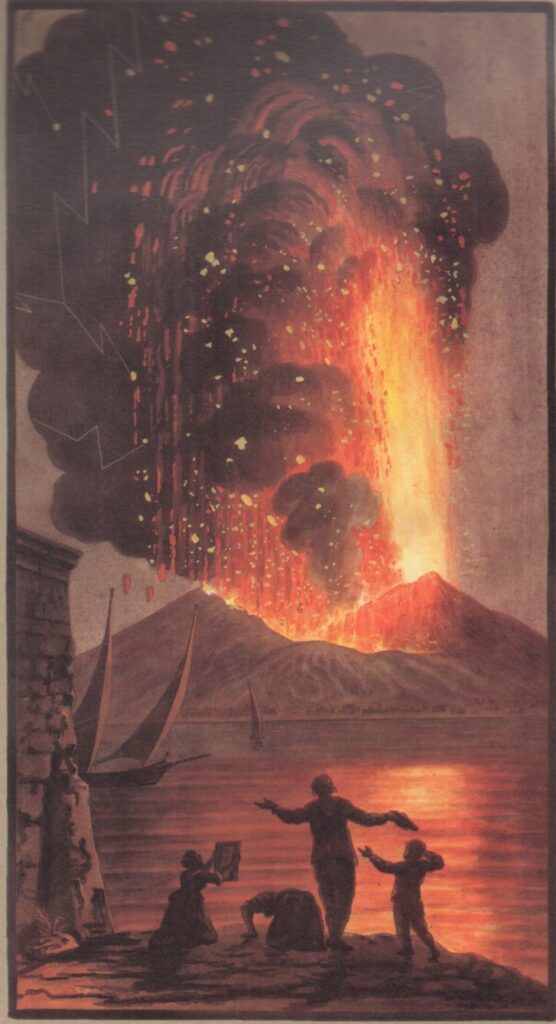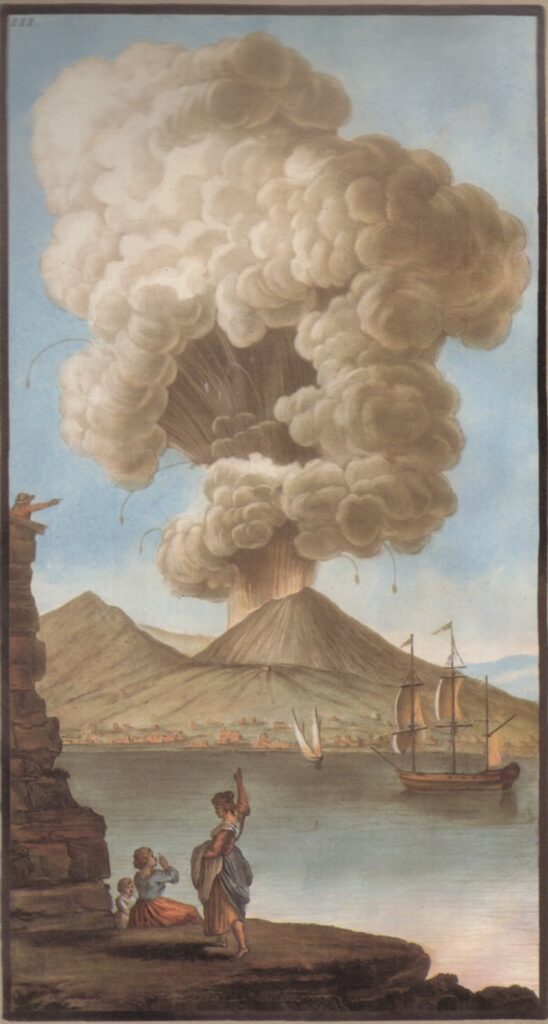William HAMILTON, Supplement to the Campi Phlegraei, Napoli, Pietro FABRIS (editore nel senso di venditore esclusivo), Francesco MORELLI ? (stampatore) 1779. Tavole II e III. Acqueforti colorate a mano (in genere ad acquerello), cm. 39 x 21,5. Autore delle gouaches originali: Pietro FABRIS. Incisore e coloritore: Anonimo.
La tavola II rappresenta l’eruzione nella notte dell’8 agosto 1779; la tav. III la mattina del 9 agosto. Il punto di vista, come indicato nelle didascalie delle tavole è, in ambo i casi, da Posillipo, ma il Vesuvio è otticamente ravvicinato rispetto alla situazione reale (Cf. Hamilton 1779 tav. I fig. 1).
Bibliografia. Sulle vicende editoriali e le tecniche esecutive: Knight 2000, in part. pp. 34-35; Jenkins and Sloan 1996, in part. 165-7. Su Hamilton: Knight 1990; Moore 1994; Thackray 1996; Wood 2006. Sulla eruzione del 1779: Nazzaro 2001, pp. 163-6; Imbò 1984, p. 101; Lirer et al. 2005, p. 59, Ricciardi 2009, pp. 401-11.
MUTAMENTI OROGRAFICI
Cono: distruzione.
In ambo le tavole l’orlo del cono risulta decurtato a sinistra, un particolare che, a mia conoscenza, non è emerso nella letteratura e che Hamilton sembra essere il solo a far rappresentare. L’attenzione di Hamilton per i mutamenti orografici è testimoniata da Hamilton 1776 tav. II.
De Bottis, 1779 accenna a mutamenti del cratere, ma solo nel testo (p. iii, 5 agosto: Si sentì un grandissimo romore del Monte; e sprofondò tutto il pianoro del suo cratere, e la soprannominata montagnuola, che v’era; e dalla cima quasi fino alle radici si spaccò il Monte (Tav. IV n. 4) e cadde nel suo seno una buona porzione del vertice; sicchè formossi un’amplissima e profonda voragine. Di questa uscirono subito densissimi globi di fumo).
Hamilton descrive il mutamento in questo modo: [p. 23] In short I found the whole face of Vesuvius changed…the Volcano appears to have likewise increased in height, the form of the crater is changed, a great piece of it’s rim towards Somma being wanting, and on the side towards the sea it is also broken.
COLONNA ERUTTIVA
Fontane di lava
Bombe vulcaniche
Fenomeni elettrici
Nubi vulcaniche
Tav. II
[p. 9; 8 agosto] […] the usual throws of red hot stones, and scoriae began […] In an istant a fountain of liquid transparent [p. 10] fire began to rise […] Puffs of smoke as black as can possibly imagined succeeded one an other hastly, and accompanied the red hot transparent and liquid lava interrupting it’s splendid brightness here, and there by patches of the darkest hue; within these puffs of smoke […] I cou’d perceive a bright, but pale electrical fire briskly palying about in zig zag lines.
Bombe vulcaniche
Tav. III
Le parabole delle bombe vulcaniche all’esterno o sopra la colonna eruttiva:
[p. 14; 9 agosto] We remarked, that several very large stones after having mounted to an immense hight, formed a parabola leaving behind them a trace of wthite smoke that marked their course; some burts in the air exactly like bombs, and others fell into the valley between Somma and Vesuvius without bursting […] they might very properly be call’d volcanick bombs.
Nubi vulcaniche
Tav. III
Vengono rappresentate le grande nubi di piroclasti e vapor d’acqua sviluppatasi il 9 agosto, che evidentemente finirono con l’occultare le emissioni laviche pure citate nel testo in rapporto allo stesso giorno.
[p. xiii; 9 agosto] The smoke was of two sorts, the one as white, as snow, and the other, as black as jet. The white as described in the former part of this journal roll’d gently mass over [p. xiv] resembling bales of the softest cotton, and the black composed of scoriae, and minute ashes shot up with force in the midst of the white smoke […].
Domenico Laurenza


